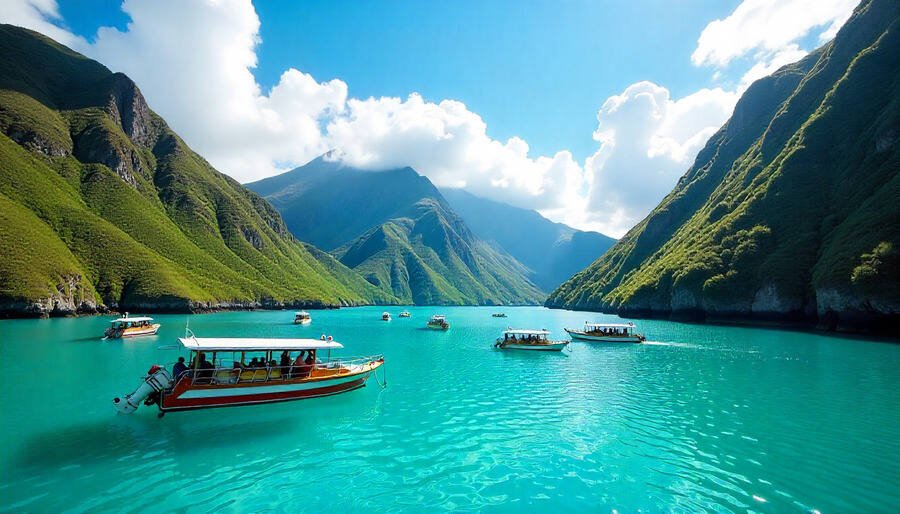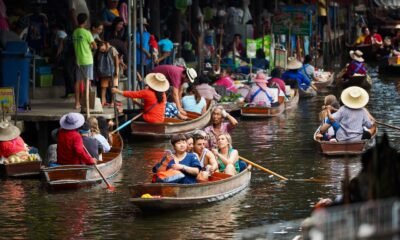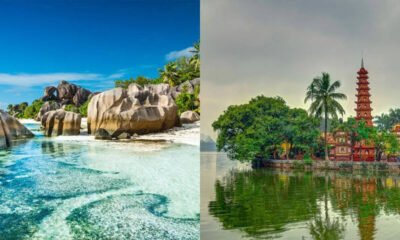Asia Travel Pulse
Thailand and Vietnam Competing for Southeast Asia’s Tourism Growth with Unique Strengths and Strategic Advancements

Published on
August 26, 2025
The tourism rivalry between Vietnam and Thailand escalates as each country tries to cater to millions of visitors using strategic modern advancements and unique capabilities. Thailand is still at the forefront and continues to lead Vietnam in tourism since tourist infrastructure and world-renowned attractions in Thailand, along with its rich culture and heritage, help Thailand maintain its lead. However, it is noteworthy that Vietnam is catching up. Its emerging luxury tourism options in addition to aggressive government policies make the country Vietnam a serving contender in the tourism arena. The competition is bound to intensify as both countries adapt to new traveler preferences and tourist-related problems such as infrastructure development and overtourism.
Thailand and Vietnam remain the most distinguished tourism hubs of Southeast Asia, and continue to shape the tourism landscape of the region. Each of these countries has uniquely positioned itself to attract international visitors, and is cumulatively receiving millions of visitors from all parts of the world. The 2024 data highlights Thailand maintaining its lead in Southeast Asia with 35.6 million international arrivals, while Vietnam experienced remarkable growth, reaching 17.5 million visitors and surpassing Singapore in overall tourist numbers.
This article explores and compares the tourism recovery, infrastructure progress, cultural attractions and, the future strategic positioning in the competitive tourism industry of Southeast Asia, to understand the drivers of tourism growth in these two countries.
Visitor Numbers and Recovery Pace
Thailand’s Recovery Post-COVID
Thailand, with its iconic destinations and established tourism infrastructure, recorded a total of 35.6 million international arrivals in 2024. This figure underscores its position as the most visited country in Southeast Asia. The revenue generated from tourism stood at approximately 1.7 trillion baht, a testament to the country’s ability to attract high volumes of international tourists. Despite this, Thailand’s recovery rate stands at 87.5% compared to pre-COVID levels, a slight lag compared to some of its neighbors.
The Chinese market continues to be a significant driver for Thailand’s tourism, accounting for 1.26 million arrivals in the first quarter of 2024 alone. Additionally, Western markets, particularly Europe and North America, also contribute substantially to Thailand’s tourism sector. However, the country faced a 20% decline in March 2024 compared to March 2019, indicating challenges in regaining pre-pandemic momentum, especially with safety concerns, such as the widely publicized kidnapping incident of a Chinese actor in Bangkok.
Vietnam’s Rapid Growth
Vietnam, on the other hand, has witnessed an incredible surge in its tourism figures. With 17.5 million visitors in 2024, the country has achieved a 38.9% year-on-year increase in arrivals. This recovery is impressive, with Vietnam reaching 98% of its pre-COVID tourism levels. Vietnam has seen impressive growth in visitors from India and China, with Indian arrivals reaching 500,000, marking a remarkable 297% increase compared to pre-pandemic figures. The country is aiming for 23 million arrivals by 2025, with its eyes set on overtaking Malaysia to claim the second spot in Southeast Asia by 2030.
Cultural and Historical Appeal
Thailand’s Cultural Heritage
Thailand’s cultural appeal is anchored in its rich Buddhist heritage, with sites such as Wat Pho, Wat Arun, and the ancient ruins of Ayutthaya and Sukhothai drawing tourists seeking spiritual and historical immersion. The country’s annual festivals, including the Songkran water festival and the Loy Krathong lantern festival, are major draws, bringing visitors from across the globe to experience traditional Thai customs and celebrations.
The country’s well-established reputation for hospitality, especially in urban centers like Bangkok, combined with its vibrant nightlife in areas such as Khao San Road, continues to enhance its cultural allure. However, the dominance of Thailand’s cultural tourism is increasingly being challenged by Vietnam’s own emerging attractions.
Vietnam’s Cultural Diversity
Vietnam, though smaller in terms of visitor numbers, offers a rich tapestry of cultural and historical experiences. The UNESCO-listed ancient town of Hoi An, the historical charm of Hanoi’s Old Quarter, and the vibrant energy of Ho Chi Minh City provide a striking contrast to the more established cultural offerings of Thailand. Moreover, Vietnam’s historical connection with French colonialism, evident in its architecture, food, and culture, adds a unique flavor to the nation’s cultural tourism.
Vietnam’s distinctive culture, along with natural wonders like Ha Long Bay and Tam Coc (often referred to as “Ha Long Bay on land”), attract travelers who are looking for less commercialized experiences. For those seeking authenticity and cultural discovery, Vietnam presents a fresh alternative to Thailand’s more mainstream attractions.
Natural Attractions: A Comparison
Thailand’s Diverse Landscapes
Thailand is well-known for its tropical beaches, including the famous islands of Phuket, Krabi, and Koh Samui, which continue to draw sun-seekers and adventure lovers alike. Its national parks, such as Khao Sok and Doi Inthanon, offer a wealth of ecotourism opportunities, including jungle treks, wildlife tours, and visits to waterfall and mountain areas.
Despite these alluring destinations, Thailand faces growing challenges from overtourism, especially in popular beach areas like Phuket and Koh Phi Phi, which suffer from overcrowding and environmental degradation.
Vietnam’s Undiscovered Gems
Vietnam’s natural landscapes offer some serious competition to Thailand’s well-known destinations. Ha Long Bay’s iconic limestone islands are world-renowned, while destinations like the rice terraces of Sa Pa and the pristine beaches of Phu Quoc Island provide tranquil alternatives to the bustling tourist crowds in Thailand.
Vietnam has made strategic efforts to diversify its tourism offerings, with emerging destinations such as Da Nang and Phu Quoc gaining popularity. These less crowded sites are perfect for travelers seeking unspoiled natural beauty and quieter experiences, positioning Vietnam as a viable option for those looking to escape the mass tourism scene.
Infrastructure and Accessibility
Thailand’s Strong Infrastructure
Thailand boasts well-developed infrastructure that includes international airports in key tourist cities such as Suvarnabhumi (Bangkok), Phuket, and Chiang Mai. Its domestic transportation system is also robust, with well-connected bus, ferry, and train networks.
Despite these advancements, Thailand’s infrastructure faces strains due to the high number of visitors. Congestion at Suvarnabhumi Airport and overcrowded tourist hotspots, particularly during peak season, have made accessibility challenging. The Thai government has responded by promoting lesser-known destinations like Chiang Rai and Isaan to reduce the pressure on more popular locations.
Vietnam’s Growing Infrastructure
Vietnam’s tourism infrastructure is still catching up with its neighbor, although rapid development is underway. Airports like Tan Son Nhat (Ho Chi Minh City) and Noi Bai (Hanoi) are showing signs of congestion. However, the upcoming Long Thanh International Airport, slated to open in 2026, will significantly increase the country’s tourism capacity, handling up to 25 million passengers annually.
Vietnam’s visa policies are relatively stricter than Thailand’s, with exemptions available for 25 countries and e-visas available for 80+. However, recent policy shifts, including 90-day e-visas and direct nonstop flights to the U.S., have made it easier for tourists to visit, contributing to the country’s growth.
Culinary Tourism
Thailand: A Culinary Destination
Thai cuisine is a central pillar of the country’s tourism appeal, offering everything from street food stalls serving pad Thai and tom yum to high-end dining experiences. The culinary scene in Bangkok is considered one of the most diverse and renowned in the world, attracting foodies from around the globe. Cooking schools and food tours also offer tourists the opportunity to immerse themselves in the flavors and techniques of Thai cuisine.
Vietnam: A Rising Culinary Hub
Vietnam’s food culture is growing in global recognition, with dishes like pho, banh mi, and “Bia Hoi” (local beer culture) capturing the attention of international travelers. The inclusion of Vietnamese restaurants in the Michelin Guide 2024 has helped elevate its culinary reputation. Vietnam’s food tourism appeals not only to budget-conscious travelers but also to luxury tourists seeking authentic experiences.
Government Policies and Promotion
Thailand’s Strategic Tourism Campaigns
The Tourism Authority of Thailand (TAT) has been instrumental in driving tourism growth with its “Amazing Thailand” campaign, which highlights the country’s natural beauty, cultural richness, and world-class hospitality. Visa exemptions for over 90 countries, alongside subsidies for key markets like China, continue to promote the country as a leading tourism destination.
Vietnam’s Focused Policy Reforms
Vietnam’s government has actively reformed its visa policies, including 90-day e-visas and expanded exemptions for key markets, to make it easier for tourists to visit. Investments in luxury tourism and the promotion of sustainable tourism practices have positioned the country as a rising star in Southeast Asia’s tourism market.
Medical and Wellness Tourism
Thailand’s Medical and Wellness Dominance
Thailand has long been a leader in medical tourism, attracting thousands of international visitors to its world-class hospitals for affordable healthcare services. Wellness tourism, including spas, yoga retreats, and holistic health resorts in places like Koh Samui and Phuket, is a growing sector appealing to health-conscious travelers.
Vietnam’s Wellness Tourism Growth
Vietnam is increasingly making a name for itself in the wellness sector, with luxury resorts in Phu Quoc and Da Nang offering yoga, spa treatments, and holistic retreats. While still behind Thailand in medical tourism, Vietnam’s emerging luxury tourism scene is attracting affluent travelers seeking tranquil, uncrowded alternatives.
Challenges and Competitive Dynamics
Thailand: Overtourism and Environmental Concerns
Overtourism remains one of Thailand’s biggest challenges, particularly in high-traffic areas like Phuket and Koh Phi Phi. The country is also grappling with environmental degradation in popular locations and the safety concerns that can arise in high-profile incidents.
Vietnam: Growth Pains
Vietnam’s tourism growth faces challenges from infrastructure bottlenecks, less flexible visa policies, and a lower global brand recognition than Thailand. However, the country’s focus on sustainability, affordability, and emerging luxury offerings positions it as a formidable competitor in Southeast Asia’s tourism race.
The competition for the region’s burgeoning tourist market persists between Vietnam and Thailand, both possessing captivating advantages to offer. Thailand retains its position as the leader due to its developed infrastructure, cultural, and historical attractions and famed tourist destinations. On the other hand, the newer competitor Vietnam is not only growing rapidly, but its low prices, luxurious Vietnam branded offerings, and favorable government policies make it an aggressive competitor. As a result, both countries are forced to adapt and continuously enhance their services to meet traveler expectations.
Thailand remains the frontrunner in tourism in Southeast Asia, but the accelerated growth and competitive benefits of Vietnam are unsettling the balance. While each country grapples with issues like overtourism in Thailand and inadequate infrastructure in Vietnam, the region’s tourism future will, in large part, be defined by the two contenders.
Asia Travel Pulse
EVA Air, Southwest Launch Partnership for Asia-US Travel Network
This Partnership Now Connects Travelers to More Routes with Greater Flexibility
This strategic agreement creates an integrated network across the participating gateway airports of both airlines. Passengers can now book a single itinerary including flights operated by both carriers, with coordinated ticketing and through-checked baggage service to their final destination. Travelers will also receive boarding passes for all segments of their journey at the first point of departure, making connections more straightforward and efficient.
“This partnership positions EVA Air for long-term growth in an evolving market by combining resources with Southwest Airlines,” said EVA Air America Head Office Executive Vice President Andrew Su. “Together, we’re streamlining operations, connecting with a broader range of travelers, and responding more swiftly to changing market needs. Beyond simply adding flight options, we are dedicated to reimagining how we serve our passengers and providing travel experiences that are more personalized, more flexible, and thoughtfully designed around their needs.”
“Our relationship with EVA Air brings new opportunities for access between
Beyond facilitating travel logistics, this interline partnership aims to offer competitive fares and broaden access in key routes, enhancing transpacific options for travelers throughout
EVA Air currently offers 89 weekly flights to major cities in the
For more information on EVA Air’s routes and to book flights, please visit www.evaair.com.
ABOUT EVA AIR:
A Star Alliance member, EVA Air was founded in 1989 as
ABOUT SOUTHWEST AIRLINES CO.
Southwest Airlines Co. operates one of the world’s most admired and awarded airlines, offering its one-of-a-kind value and Hospitality at 117 airports across 11 countries. Southwest took flight in 1971 to democratize the sky through friendly, reliable, and low-cost air travel and now carries more air travelers flying nonstop within
- Based on
U.S. Dept. of Transportation quarterly Airline Origin & Destination Survey as of Q1 2025 - Full-time equivalent active Employees as of June 30, 2025
View original content to download multimedia:https://www.prnewswire.com/news-releases/eva-air-and-southwest-airlines-launch-interline-partnership-to-expand-seamless-travel-between-asia-and-north-america-302539209.html
SOURCE EVA Airways Corporation
Asia Travel Pulse
5 essential podcasts for female travellers

Female travellers can find smart guidance in these five podcasts covering safety, planning, community and adventure
Travel can be liberating, messy and personal. For women, it also comes with considerations men rarely have to make: whether to walk through a neighbourhood after dark, what to wear to deflect attention or who to trust when plans fall apart. Yet, the joys are real. You read a city differently, pack lighter, bargain smarter and find allies quickly. Podcasts bridge the gap between guidebooks and lived experience. They offer practical checklists, safety know-how, straight talk on budgets and visas, plus stories that make long transfers feel shorter. They also act as a sounding board when you need to sanity-check plans without the noise of social media. In short, podcasts give female travellers practical company between stops.
Here are five podcasts that speak to female travellers with clear advice and well-reported stories.
Read more: Solo travel is on the rise in Malaysia: here’s what’s behind it
Asia Travel Pulse
Tourist deaths on Thailand’s beaches spark alarm, calls to boost safety

The recent deaths of four tourists in less than a week on Phuket beaches are raising alarm and calls for stricter safety measures as strong monsoon currents, lack of lifeguards and venomous sea slugs threaten swimmers on the Thai island.
All of the deaths happened over three days. On Wednesday, a 68-year-old Swedish man collapsed on Kata Beach while wading out of shallow water and could not be revived by lifeguards, the Thai Examiner news website reported.
Two days later, the body of a 28-year-old American man washed ashore on Patong Beach. Police have sent both bodies for autopsies to determine the cause of death.
A third man, a 35-year-old Russian, drowned early on Thursday while on a midnight swim between Banana Beach and Nai Thon Beach, Khaosod newspaper reported. According to his 24-year-old girlfriend, they had entered the sea around 12.30am when large waves suddenly struck. He managed to push her towards the shore but was swallowed by the waves.
Hours later, again on Kata Beach, bystanders had to rescue two men who were struggling in the water as there were no lifeguards around. One was saved but the other died.
A 10-year-old Canadian girl was swept away while swimming with her family on the same beach earlier in the month when, despite strong waves, no red warning flags had been posted.
-

 Brand Stories1 month ago
Brand Stories1 month agoBloom Hotels: A Modern Vision of Hospitality Redefining Travel
-

 Brand Stories1 month ago
Brand Stories1 month agoCheQin.ai sets a new standard for hotel booking with its AI capabilities: empowering travellers to bargain, choose the best, and book with clarity.
-

 Destinations & Things To Do1 month ago
Destinations & Things To Do1 month agoThis Hidden Beach in India Glows at Night-But Only in One Secret Season
-

 Destinations & Things To Do1 month ago
Destinations & Things To Do1 month agoUntouched Destinations: Stunning Hidden Gems You Must Visit
-

 AI in Travel1 month ago
AI in Travel1 month agoAI Travel Revolution: Must-Have Guide to the Best Experience
-

 Family Travel2 months ago
Family Travel2 months agoThings to Do Indoors in New Jersey
-

 Brand Stories2 months ago
Brand Stories2 months agoVoice AI Startup ElevenLabs Plans to Add Hubs Around the World
-

 Brand Stories1 month ago
Brand Stories1 month agoContactless Hospitality: Why Remote Management Technology Is Key to Seamless Guest Experiences
-

 Restaurants & Food5 months ago
Restaurants & Food5 months ago10 New Restaurants In Delhi NCR To Head To This Month
-

 Brand Stories2 months ago
Brand Stories2 months agoHow Elon Musk’s rogue Grok chatbot became a cautionary AI tale













You must be logged in to post a comment Login